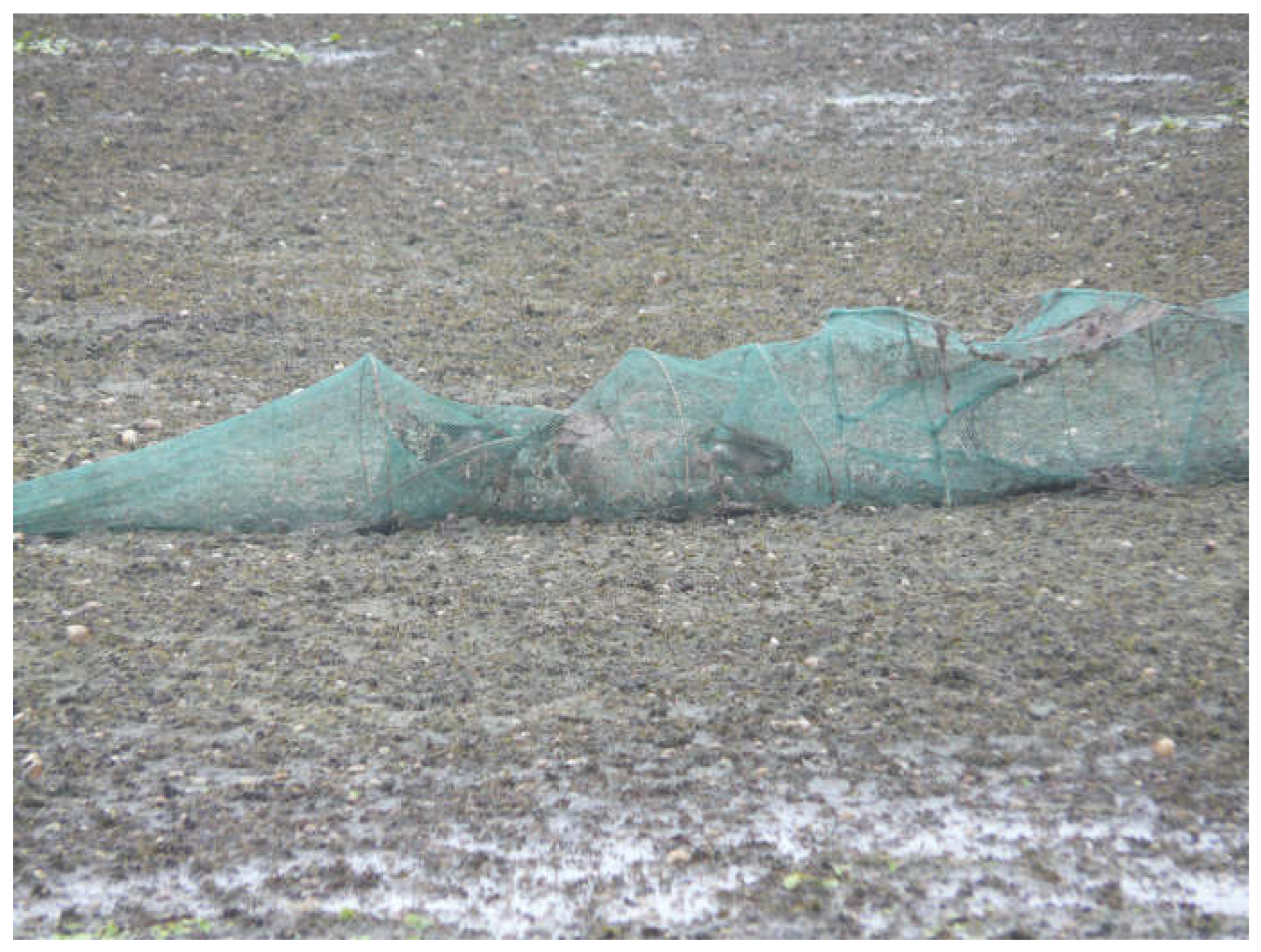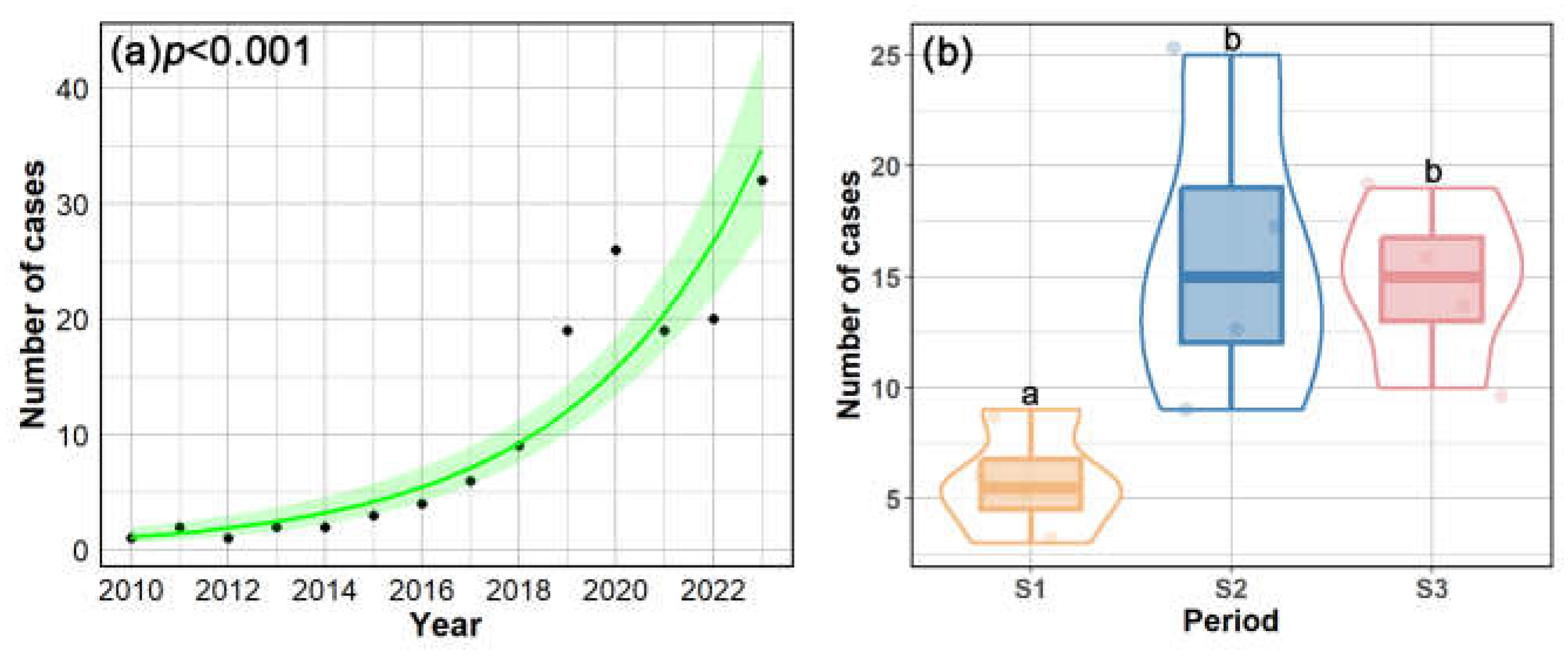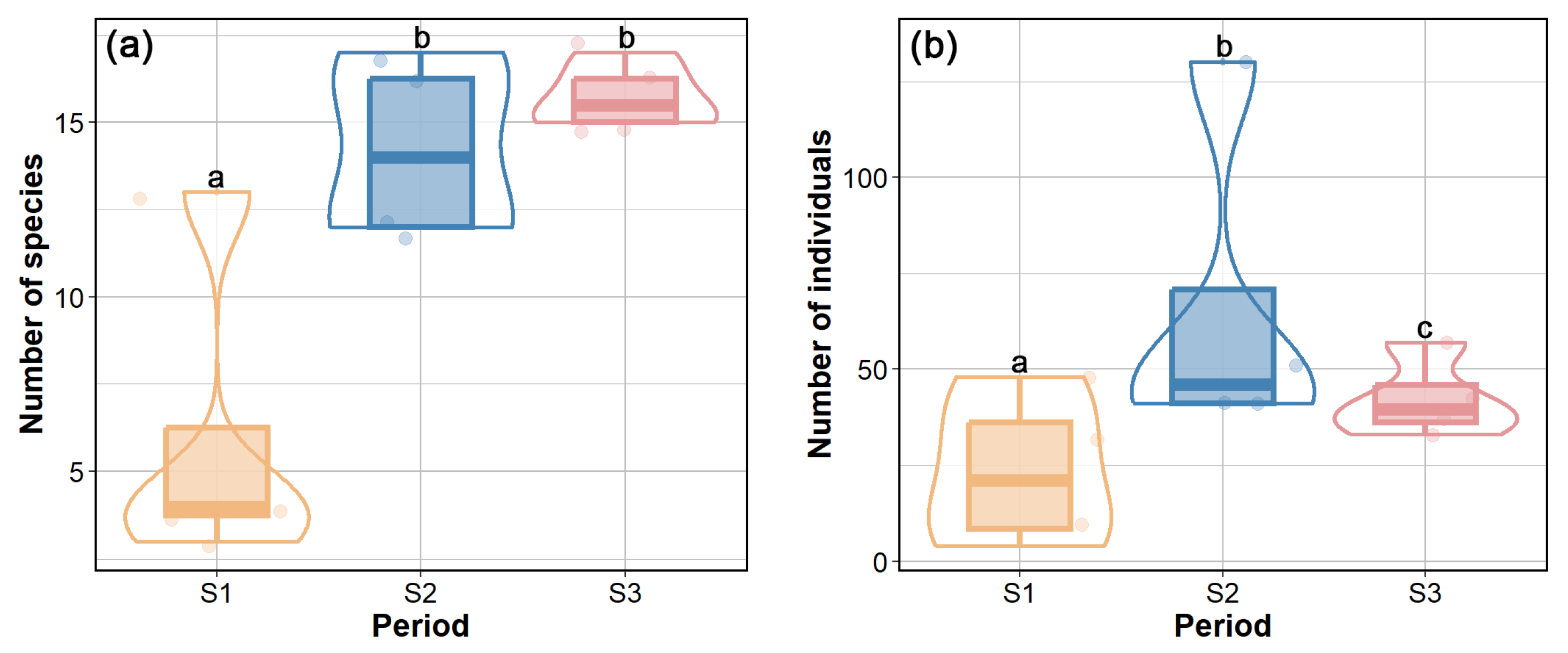Social Media Reveals Potential Threat of Crayfish Trap to Birds
Abstract
1. Introduction
2. Materials and Methods
3. Results
3.1. Bird Species Caught by Crayfish Traps
3.2. Spatial and Temporal Characteristics of Bycatch in Crayfish Traps
3.3. Factors Influencing the Number of Bird Bycatch in Crayfish Traps
3.4. Bird Mortality Rates in Crayfish Traps
4. Discussion
4.1. Bird Bycatch Species in Crayfish Traps
4.2. Spatial and Temporal Distribution of Bycatch Cases in Crayfish Traps
4.3. Limitations of This Study
4.4. Management Recommendations
5. Conclusions
Supplementary Materials
Author Contributions
Funding
Institutional Review Board Statement
Data Availability Statement
Acknowledgments
Conflicts of Interest
References
- Lotze, H.K. Marine biodiversity conservation. Curr. Biol. 2021, 31, R1190–R1195. [Google Scholar] [CrossRef] [PubMed]
- Telesetsky, A. Overfishing and Bycatch. In International Farm Animal, Wildlife and Food Safety Law; Steier, G., Patel, K.K., Eds.; Springer: Cham, Switzerland, 2017; pp. 405–431. [Google Scholar] [CrossRef]
- Soykan, C.U.; Moore, J.E.; Zydelis, R.; Crowder, L.B.; Safina, C.; Lewison, R.L. Why study bycatch? An introduction to the Theme Section on fisheries bycatch. Endanger. Species Res. 2008, 5, 91–102. [Google Scholar] [CrossRef]
- Dias, M.P.; Martin, R.; Pearmain, E.J.; Burfield, I.J.; Small, C.; Phillips, R.A.; Yates, O.; Masello, J.; Garthe, S.; Oppel, S.; et al. Threats to seabirds: A global assessment. Biol. Conserv. 2019, 237, 525–537. [Google Scholar] [CrossRef]
- Žydelis, R.; Bellebaum, J.; Österblom, H.; Vetemaa, M.; Schirmeister, B.; Stipniece, A.; Dagys, M.; Hario, M.; Garthe, S. Bycatch in gillnet fisheries—An overlooked threat to waterbird populations. Biol. Conserv. 2009, 142, 1269–1281. [Google Scholar] [CrossRef]
- Pardo, D.; Forcada, J.; Wood, A.G.; Tuck, G.N.; Ireland, L.; Pradel, R.; Croxall, J.P.; Phillips, R.A. Additive effects of climate and fisheries drive ongoing declines in multiple albatross species. Proc. Natl. Acad. Sci. USA 2017, 114, E10829–E10837. [Google Scholar] [CrossRef] [PubMed]
- Carenton, N.; Defos du Rau, P.; Wachoum, A.S.; Ducros, D.; Suet, M.; Deschamps, C.; Trolliet, F.; Mondain-Monval, J.Y. Migration of humans fleeing conflict in the Lake Chad region may increase pressures on natural resources in Lake Fitri (Chad): A case study on waterbirds. J. Appl. Ecol. 2024, 61, 2231–2234. [Google Scholar] [CrossRef]
- Villar, D.A.; Thomsen, B.; Paca-Condori, A.C.; Gutiérrez Tito, E.R.; Velásquez-Noriega, P.; Mamani, E.; Sainz-Borgo, C.; Gosler, A.G. Indigenous–wildlife conflict and coexistence in the altiplano. J. Ethnobiol. 2024, 44, 141–154. [Google Scholar] [CrossRef]
- Raby, G.D.; Colotelo, A.H.; Blouin-Demers, G.; Cooke, S.J. Freshwater commercial bycatch: An understated conservation problem. BioScience 2011, 61, 271–280. [Google Scholar] [CrossRef]
- Jarić, I.; Correia, R.A.; Brook, B.W.; Buettel, J.C.; Courchamp, F.; Di Minin, E.; Gledhill, K.S.; Jepson, P.; Kalinkat, G.; Ladle, R.J.; et al. iEcology: Harnessing large online resources to generate ecological insights. Trends Ecol. Evol. 2020, 35, 630–639. [Google Scholar] [CrossRef] [PubMed]
- Windsor, F.M.; van den Hoogen, J.; Crowther, T.W.; Evans, D.M. Using ecological networks to answer questions in global biogeography and ecology. J. Biogeogr. 2023, 50, 57–69. [Google Scholar] [CrossRef]
- Jarić, I.; Bellard, C.; Correia, R.A.; Courchamp, F.; Douda, K.; Essl, F.; Jeschke, J.M.; Kalinkat, G.; Kalous, L.; Novoa, A.; et al. Invasion culturomics and iEcology. Conserv. Biol. 2021, 35, 447–451. [Google Scholar] [CrossRef] [PubMed]
- Sharp, T.R.; Garshelis, D.L.; Larson, W. A most aggressive bear: Safari videos document sloth bear defense against tiger predation. Ecol. Evol. 2024, 14, e11524. [Google Scholar] [CrossRef] [PubMed]
- Depauw, L.; Blondeel, H.; De Lombaerde, E.; De Pauw, K.; Landuyt, D.; Lorer, E.; Verheyen, K.; De Frenne, P. The use of photos to investigate ecological change. J. Ecol. 2022, 110, 1220–1236. [Google Scholar] [CrossRef]
- Zheng, G. A Checklist on the Classification and Distribution of the Birds of China, 4th ed.; Science Press: Beijing, China, 2023. [Google Scholar]
- Huang, Y. Estimation of Resource Status and Genetic Diversity Analysis for Procambarus clarkii Populations in the Poyang Lake Wetland and the Middle and Lower Reaches of the Yangtze River Based on AFLP Markers. Master’s Thesis, Nanchang University, Nanchang, China, 2012. [Google Scholar]
- Song, L.L. Non-Destructive Evaluation of Developmental and Fullness of Eriocheir sinensis and Detection of Volatile Odor Components. Master’s Thesis, Shanghai Ocean University, Shanghai, China, 2018. [Google Scholar]
- Smolowitz, R.J. Lobster, Homarus americanus, trap design and ghost fishing. Mar. Fish. Rev. 1978, 40, 2–8. [Google Scholar]
- Yu, X.; Hao, X.; Dang, Z.; Yang, L.; Wang, X.; Zhang, Y.; Cai, J.; Zhang, Y. Development Report of China’s Crayfish Industry (2023). Chin. Fish. 2023, 7, 26–31. [Google Scholar]
- Xiao, F.; Liu, Z.; Guo, Y.; Zhu, Z.; Ma, D.; Tang, J. Development Report of China’s Crayfish Industry (2017). Chin. Fish. 2017, 7, 8–17. [Google Scholar]
- China Internet Network Information Center (CNNIC). The 27rd Statistical Report on China’s Internet Development. Available online: https://www.cnnic.cn/n4/2022/0401/c88-779.html (accessed on 17 May 2025).
- China Internet Network Information Center (CNNIC). The 53rd Statistical Report on China’s Internet Development. Available online: https://www.cnnic.cn/n4/2024/0322/c88-10964.html (accessed on 17 May 2025).
- Yan, Z.; Hu, S.; Du, Y.; Liang, J.; Chen, S.; Han, L.; Gebbink, H.; Hu, G.; Liu, X. Social media unveils the hidden but high magnitude of human-mediated biological invasions in China. Curr. Biol. 2024, 34, R47–R49. [Google Scholar] [CrossRef] [PubMed]
- List of Prohibited Fishing Gear for Key Waters in the Yangtze River Basin. Available online: http://www.moa.gov.cn/govpublic/CJB/202110/t20211015_6379529.htm (accessed on 24 February 2025).
- Fisheries Management Regulations of Jiangsu Province. Available online: https://zrzy.jiangsu.gov.cn/gtxxgk/nrglIndex.action?type=2&messageID=2c9082546ceed80c016cf10eff0d00b2 (accessed on 24 February 2025).
- Opinions on Strengthening the Management of Trap Net Fishing Gear. Available online: https://nyt.hubei.gov.cn/bmdt/ztzl/zxzt/xzgfxwjk/202309/t20230913_4837673.shtml (accessed on 24 February 2025).





| Analysis | Comparison | β Estimate | 95% CI | p-Value |
|---|---|---|---|---|
| Temporal trend | Year effect | 0.264 | [0.211, 0.318] | <0.001 *** |
| Period comparison | S2 vs. S1 | 1.008 | [0.530, 1.485] | <0.001 *** |
| S3 vs. S1 | 0.959 | [0.478, 1.440] | <0.001 *** | |
| S3 vs. S2 | −0.049 | [−0.402, 0.305] | 0.960 |
| Response | Comparison | β Estimate | 95% CI | p-Value |
|---|---|---|---|---|
| Species | S2 vs. S1 | 0.865 | [0.388, 1.342] | 0.001 ** |
| S3 vs. S1 | 0.965 | [0.495, 1.435] | <0.001 *** | |
| S3 vs. S2 | 0.100 | [−0.258, 0.458] | 0.846 | |
| Individuals | S2 vs. S1 | 1.029 | [0.793, 1.265] | <0.001 *** |
| S3 vs. S1 | 0.587 | [0.334, 0.840] | <0.001 *** | |
| S3 vs. S2 | −0.442 | [−0.635, −0.249] | <0.001 *** |
| Variable | β Estimate | 95% CI | z-Value | p-Value | VIF |
|---|---|---|---|---|---|
| Proportion of water area | 0.156 | [0.141, 0.171] | 20.900 | <0.001 *** | 1.059 |
| Total yield of freshwater shrimp and crabs | 0.006 | [0.003, 0.008] | 4.473 | <0.001 *** | 1.059 |
| Order | Family | Species | Individual Number |
|---|---|---|---|
| Galliformes | Phasianidae | Japanese Quail (Coturnix japonica) | 1 |
| Anseriformes | Anatidae | Bean Goose (Anser fabalis) | 5 |
| Mallard (Anas platyrhynchos) | 2 | ||
| Eastern Spot-billed Duck (Anas zonorhyncha) | 3 | ||
| Green-winged Teal (Anas crecca) | 4 | ||
| Baer’s Pochard (Aythya baeri) | 1 | ||
| Mandarin Duck (Aix galericulata) | 1 | ||
| Podicipediformes | Podicipedidae | Little Grebe (Tachybaptus ruficollis) | 1 |
| Gruiformes | Rallidae | Brown-cheeked Rail (Rallus indicus) | 1 |
| Common Moorhen (Gallinula chloropus) | 6 | ||
| Common Coot (Fulica atra) | 8 | ||
| Charadriiformes | Rostratulidae | Greater Painted Snipe (Rostratula benghalensis) | 1 |
| Scolopacidae | Pintail Snipe (Gallinago stenura) | 1 | |
| Common Snipe (Gallinago gallinago) | 8 | ||
| Spotted Redshank (Tringa erythropus) | 3 | ||
| Green Sandpiper (Tringa ochropus) | 3 | ||
| Pelecaniformes | Ardeidae | Yellow Bittern (Ixobrychus sinensis) | 1 |
| Striated Heron (Butorides striata) | 1 | ||
| Chinese Pond Heron (Ardeola bacchus) | 4 | ||
| Passeriformes | Paridae | Cinereous Tit (Parus major) | 1 |
| Sturnidae | Red-billed Starling (Spodiopsar sericeus) | 1 | |
| Motacillidae | Gray Wagtail (Motacilla cinerea) | 1 | |
| White Wagtail (Motacilla alba) | 3 | ||
| Unrecognizable | 52 |
Disclaimer/Publisher’s Note: The statements, opinions and data contained in all publications are solely those of the individual author(s) and contributor(s) and not of MDPI and/or the editor(s). MDPI and/or the editor(s) disclaim responsibility for any injury to people or property resulting from any ideas, methods, instructions or products referred to in the content. |
© 2025 by the authors. Licensee MDPI, Basel, Switzerland. This article is an open access article distributed under the terms and conditions of the Creative Commons Attribution (CC BY) license (https://creativecommons.org/licenses/by/4.0/).
Share and Cite
Gong, C.; Hu, W.; Chen, T.; Wang, Z.; Lu, C. Social Media Reveals Potential Threat of Crayfish Trap to Birds. Diversity 2025, 17, 374. https://doi.org/10.3390/d17060374
Gong C, Hu W, Chen T, Wang Z, Lu C. Social Media Reveals Potential Threat of Crayfish Trap to Birds. Diversity. 2025; 17(6):374. https://doi.org/10.3390/d17060374
Chicago/Turabian StyleGong, Chao, Wei Hu, Taiyu Chen, Zhenqi Wang, and Changhu Lu. 2025. "Social Media Reveals Potential Threat of Crayfish Trap to Birds" Diversity 17, no. 6: 374. https://doi.org/10.3390/d17060374
APA StyleGong, C., Hu, W., Chen, T., Wang, Z., & Lu, C. (2025). Social Media Reveals Potential Threat of Crayfish Trap to Birds. Diversity, 17(6), 374. https://doi.org/10.3390/d17060374






